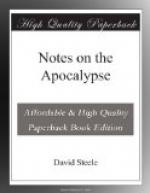3. And when he had opened the second seal, I heard the second beast say, Come and see.
4. And there went out another horse that was red; and power was given to him that sat thereon to take peace from the earth, and that they should kill one another: and there was given unto him a great sword.
V. 3,4.—The opening of the “second seal” furnishes occasion for the “second animal” to cry, “Come and see.” It is the customary business of faithful ministers to invite the disciples of Christ to a contemplation of his providential procedure. “Come, behold the works of the Lord.” (Ps. xlvi. 8.) This is the call of the ministry represented by the symbol of a “calf or young ox.” “Patient continuance in well doing” is the special duty of Christ’s servants in times of suffering. And such seems to be the import of the emblem, the “red horse.” By the horse, singly considered, we are to understand a dispensation of providence. So we are to view it as a symbol in Zech. i. 8; vi. 1-8. The prophet said, “O, my Lord, what are these?... And the man answered,—These are they whom the Lord hath sent to walk to and fro through the earth.” We speak familiarly of a “dispensation of the gospel,”—the “white horse.” Our attention is now called to a “red horse,”—fiery, as the word imports. The character of the dispensation is thus indicated as bloody. Wars should prevail so as to “take peace from the earth.” “They should kill one another.” The instrument of slaughter is seen,—“a great sword.” Mutual slaughter does not seem to harmonize with the idea of persecution, by




